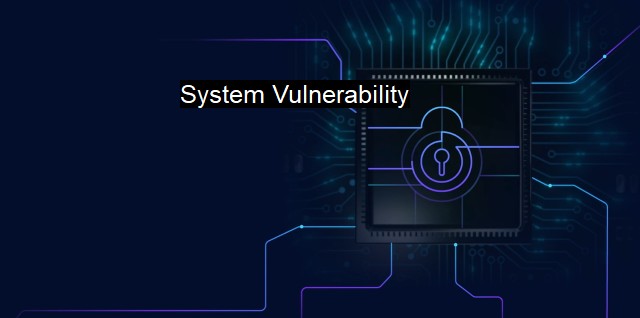What is System Vulnerability?
Exploring System Vulnerability and its Importance in Cybersecurity and Antivirus Software
System vulnerability has been acknowledged as a major concern in the cybersecurity landscape. It refers to security concerns arising from imperfections, errors, and loopholes nestled within networked digital systems and processes, exposing them to a heightened possibility of unauthorized access, damage, disruption, or data theft. This understanding becomes even more relevant in the current world characterized by an increasing reliance on computing and a fierce networking appetite amid the proliferation of the Internet.In computer mechanism parlance, a system vulnerability is essentially a weakness that allows for an outsider threat to infiltrate a system's security measures. These weaknesses can take on a variety of forms such as a flaw in the design, a programming error, or mismanagement of settings and preferences. These vulnerabilities function as loopholes that direct invaders bypass security defenses, giving them unsolicited access to vulnerable systems or databases.
Make no mistake, system vulnerabilities, if not addressed promptly and comprehensively, have the potential to be disastrous for an organization. They provide hackers or threat actors the ideal foothold to subpoena critical industrial, retail, military, medical, or sensitive personal data. Once these threat actors gain access, they selectively hijack, exploit, severely jeopardize, or corrupt the sensitive information to perpetrate fraudulent activities, making system vulnerabilities extremely detrimental to an organization's security posture.
Understanding the nature of system vulnerabilities aids organizations in protecting critical infrastructure as well as confidential data. Ideally, the first step toward protection involves engaging vulnerability scanning measures. This allows organizations to detect existing weaknesses systematically, consequently rectifying any security gaps before any opportunistic invader uncovers them.
It is now widely accepted that companies and individuals need a safety net of firewalls and antivirus software to secure their systems against unauthorized access. An antivirus is designed to detect, prevent, and access remedial measures against various types of malware, including adware, ransomware, and spyware. Besides, antivirus also conducts real-time scans of a computer or network to flag and disable malicious software or dubious links before they can cause absolute havoc in the organizational systems.
Even the best antivirus might not be able to bridge the vulnerability gap in entirety. This is where a balanced blend between a strong inbuilt device defense powered by the latest antivirus coupled with an elaborative vulnerability management program plays a pivotal role.
Howbeit, one often overlooked area in winning the battle against system vulnerabilities is user education or human factors. Implementing robust cybersecurity and antivirus measures is futile if users are ignorant about necessary precautions, clicking on malicious links, or opening dubious emails. Therefore, creating and fostering cybersecurity awareness in users is a crucial strategy in managing and controlling system vulnerabilities.
System vulnerability emphasizes a fundamental conundrum in cybersecurity frameworks as today's interconnected organizations increasingly rely on advanced technologies. The trade-off between robust functionality and secure systems renders organizations prone to flaws and breaches. Hence, there is a need for a collective and continuous tightening of security measures, wherein identifying and correcting system vulnerabilities act as a paramount strategy to mitigate potential damaging risks to secure both organizational and personal information.
Vulnerability management begins from understanding the concept of system vulnerability, why it poses a threat, and how it can be addressed adequately. Continued efforts on vulnerability scanning, timely patching of discovered loopholes, deploying updated versions of antivirus software that is robust to latest threats, enhancing controls, and imparting user-Trumped knowledge and awareness serves as the cornerstone to realizing robust cybersecurity systems. It isn't a one-step process but instead, a diligent circle of acknowledging vulnerabilities, remedying the risks, and ensuring continuous system monitoring. With the ever-evolving cyber threat landscape, these practices never retire but adaptively evolve to keep infections and breaches at bay. The attempt to prevent system vulnerabilities in itself serves as the organization's best line of defense in the cybersecurity ambit.

System Vulnerability FAQs
What is a system vulnerability in the context of cybersecurity?
A system vulnerability in the context of cybersecurity refers to a weakness or flaw in software or hardware that could be exploited by attackers to gain unauthorized access to a system, steal data, or cause damage.Why is it important to address system vulnerabilities?
It is important to address system vulnerabilities because they can leave systems open to cyber attacks, which can result in data breaches, financial losses, and reputational damage.How can system vulnerabilities be mitigated?
System vulnerabilities can be mitigated through the use of antivirus software and other security measures, such as firewalls and intrusion detection systems. It is also important to keep software up-to-date with the latest patches and updates.What should I do if I suspect my system has been compromised due to a vulnerability?
If you suspect your system has been compromised due to a vulnerability, you should immediately disconnect from the internet and seek assistance from a cybersecurity professional. You should also change all of your passwords and monitor your accounts for suspicious activity.| | A | | | B | | | C | | | D | | | E | | | F | | | G | | | H | | | I | | | J | | | K | | | L | | | M | |
| | N | | | O | | | P | | | Q | | | R | | | S | | | T | | | U | | | V | | | W | | | X | | | Y | | | Z | |
| | 1 | | | 2 | | | 3 | | | 4 | | | 7 | | | 8 | | |||||||